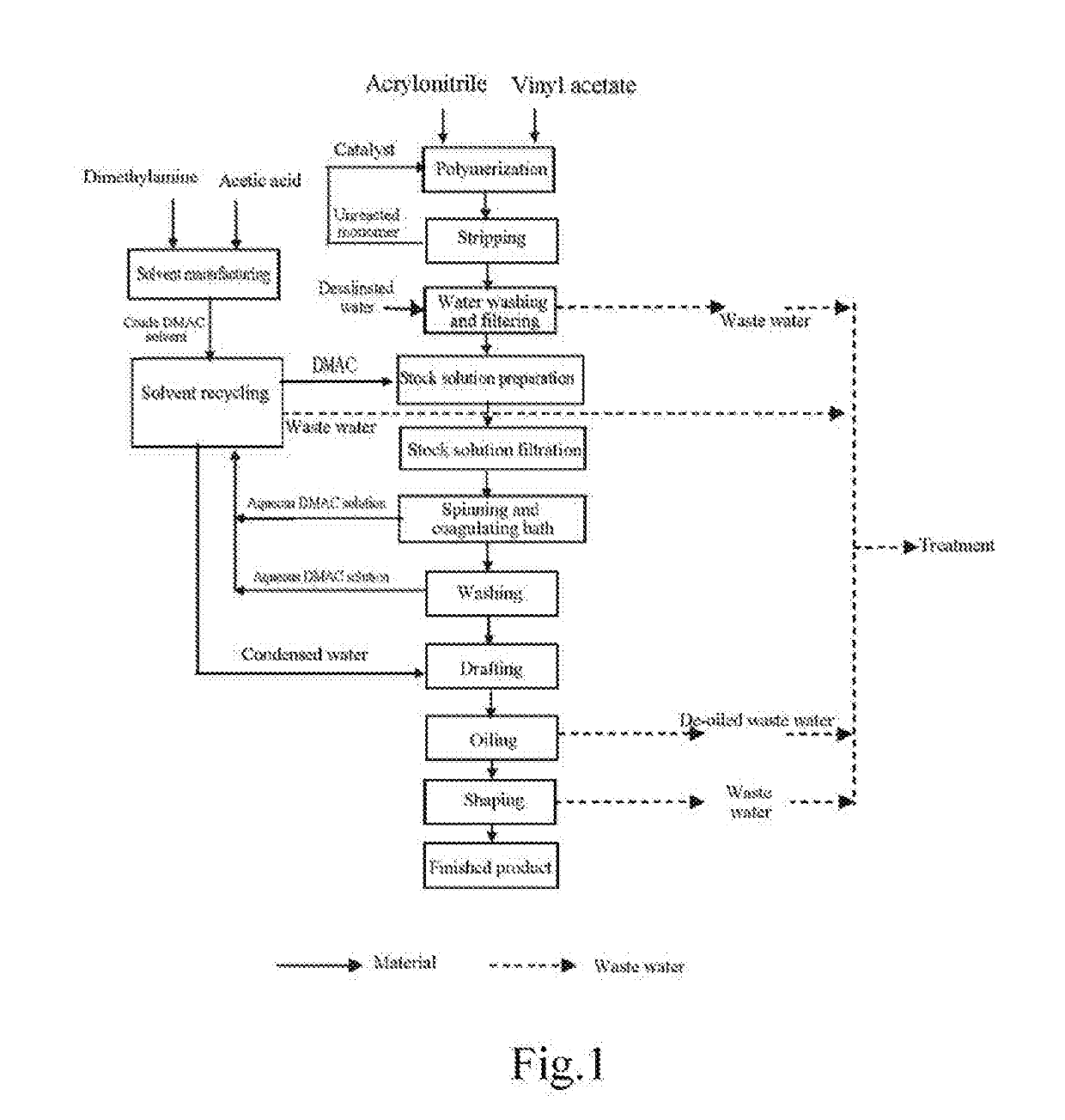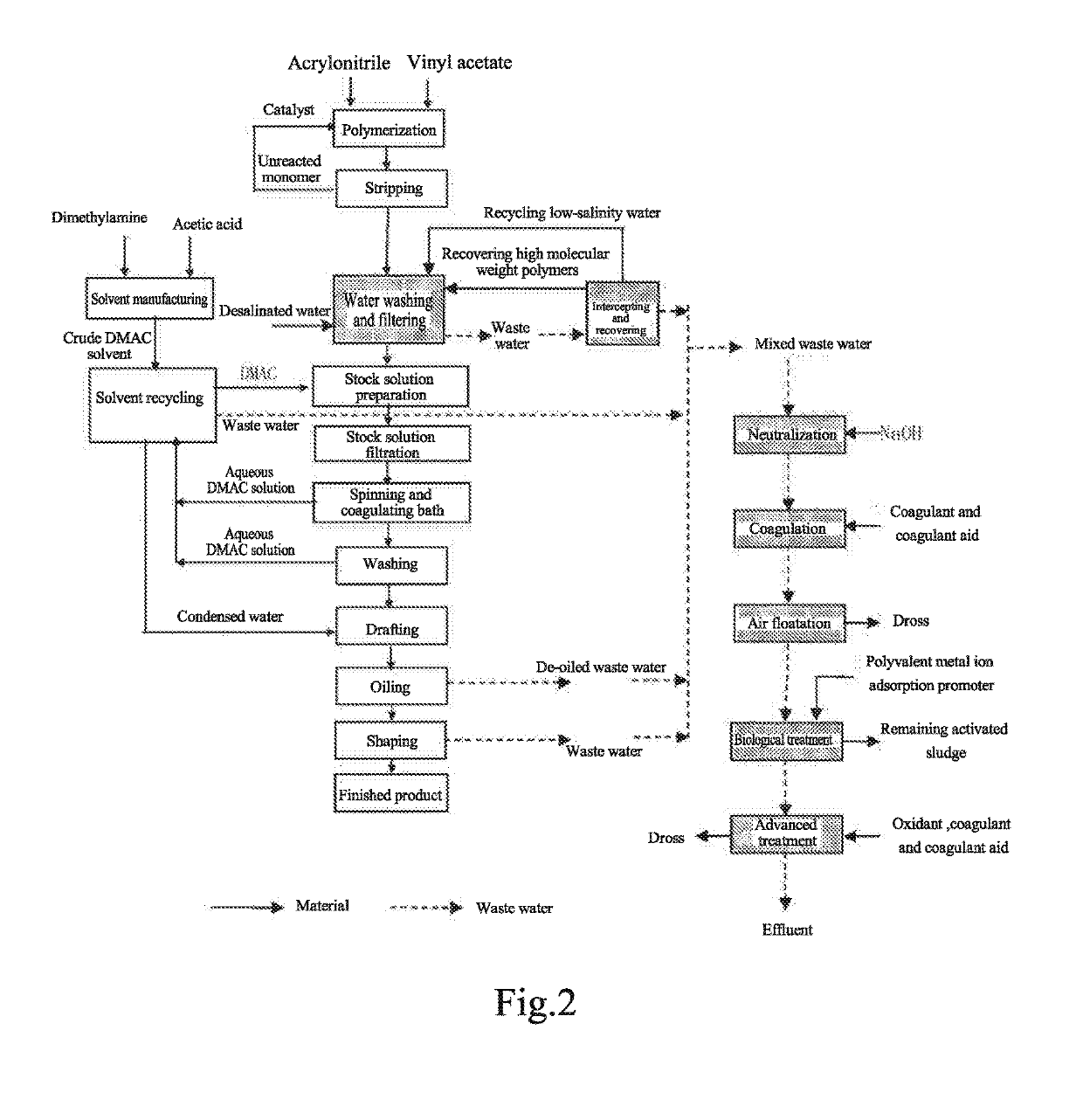Method for treating waste water and recovering resources in acrylic fiber production
a technology for acrylic fiber and wastewater treatment, applied in water treatment multi-stage treatment, water/sewage multi-stage treatment, nature of treatment water, etc., can solve the problems of low-molecular weight polymers that are difficult to remove using conventional techniques, lack of a technology aimed at reducing pollutants, and the traditional treatment process is difficult to meet standards, etc., to achieve the effect of reducing the difficulty and the cost of treatment, reducing the amount of non-degradable organics, and increasing the difficulty of treatmen
- Summary
- Abstract
- Description
- Claims
- Application Information
AI Technical Summary
Benefits of technology
Problems solved by technology
Method used
Image
Examples
example 1
[0026]FIG. 1 shows the traditional acrylic fiber production plants and the process thereof, by which the COD for the total drainage of the plant is up to 710 mg / L.
[0027]Using the method of the present invention, the traditional plants and the process thereof were modified as follows:
[0028](1) By adding a ceramic membrane filter having the pore size of 0.5 μm in the water-washing and filtering unit, the high-molecular-weight polymer was intercepted and recovered. 100 g polymer was intercepted and recovered per ton wastewater, and the COD of the wastewater was decreased by 230 mg / L. The high-molecular-weight polymer intercepted was returned back to the water-washing and filtering unit after back-washing, precipitating and concentrating, and then entered into the product finally. Part of the filtrate was used as low salinity water for water-washing and filtering the polymer.
[0029](2) The effluent from the water-washing and filtering unit was subjected to coagulation and air flotation t...
example 2
[0032]FIG. 1 shows the traditional acrylic fiber production plants and the process thereof, by which the COD for the total drainage of the plant was up to 753 mg / L.
[0033]Using the method of the present invention, the traditional plants and the process thereof were modified as follows:
[0034](1) By adding a fabric filter having the pore size of 1 μm to the water-washing and filtering unit, the high-molecular-weight polymer was intercepted and recovered. 80 g polymer was intercepted and recovered per ton wastewater, and the COD of the wastewater was decreased by 200 mg / L. The high-molecular-weight polymer intercepted was returned back to the water-washing and filtering unit after back-washing and precipitating, and enters into the product finally. Part of the filtrate was used as low salinity water for water-washing and filtering the polymer.
[0035](2) The effluent from the water-washing and filtering unit was subjected to coagulation and air flotation treatment, wherein the coagulant w...
example 3
[0038]FIG. 1 shows the traditional acrylic fiber production plants and the process thereof, by which the COD for the total drainage of the plant was up to 850 mg / L.
[0039]Using the method of the present invention, the traditional plants and the process thereof were modified as follows:
[0040](1) By adding an acrylic fiber tow filter in the water-washing and filtering unit, the high-molecular-weight polymer was intercepted and recycled. 120 g polymer was intercepted and recovered per ton wastewater, accordingly, the COD of the wastewater was decreased by 260 mg / L. The high-molecular-weight polymer intercepted was returned back to the water-washing and filtering unit after back-washing and precipitating, and enters into the product finally.
[0041](2) The effluent from the filtering unit was subjected to coagulation and air flotation treatment, wherein the coagulant was poly aluminum chloride and the amount was 200 mg / L; the coagulant aid was polyacrylamide and the amount was 5 mg / L. The ...
PUM
| Property | Measurement | Unit |
|---|---|---|
| height | aaaaa | aaaaa |
| time | aaaaa | aaaaa |
| COD | aaaaa | aaaaa |
Abstract
Description
Claims
Application Information
 Login to View More
Login to View More - R&D
- Intellectual Property
- Life Sciences
- Materials
- Tech Scout
- Unparalleled Data Quality
- Higher Quality Content
- 60% Fewer Hallucinations
Browse by: Latest US Patents, China's latest patents, Technical Efficacy Thesaurus, Application Domain, Technology Topic, Popular Technical Reports.
© 2025 PatSnap. All rights reserved.Legal|Privacy policy|Modern Slavery Act Transparency Statement|Sitemap|About US| Contact US: help@patsnap.com


